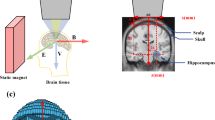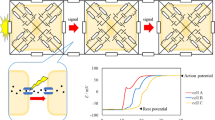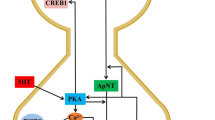Abstract
A pilocarpine/lithium model of status epilepticus is an effective tool allowing one to study the principles of development of temporal epilepsy. It is believed that, in addition to the corresponding modifications of the efficacy of synaptic transmission, changes in the endogenous properties of neuronal activity can promote repetitive epileptiform activity. We measured the accommodation parameters of spike generation by isolated neurons of the CA1 hippocampal area obtained from 14-day-old rats 2 or 24 h after they had been subjected to an epileptization procedure, as well as from control rats of the same age. The spike activity of the neurons was initiated by their depolarization with a long-lasting stimulus in a current-clamp mode under conditions of perforated patch clamp. We found that the initial phase of accommodation manifested as a rapid increase in interspike intervals immediately after application of the depolarizing stimulus became significantly shorter in rats 24 h after epileptization; at the same time, the characteristics of the late phase of accommodation underwent no changes. In addition, the mean number of generated action potentials dropped. Such changes were not found in neurons of rats 2 h after epileptization. It is hypothesized that the above effect is compensatory and not injuring; it can develop because of prolonged abnormal activation of neurons in the course of epileptic attacks.
Similar content being viewed by others
References
H. Gastaut, “Classification of status epilepticus,” Adv. Neurol., 34, 15–35 (1983).
N. B. Fountain, “Status epilepticus: risk factors and complications,” Epilepsia, 41, Suppl. 2, S23–S30 (2000).
J. Wellmer, H. Su, H. Beck, et al., “Long-lasting modification of intrinsic discharge properties in subicular neurons following status epilepticus,” Eur. J. Neurosci., 16, 259–266 (2002).
E. R. Sanabria, H. Su, and Y. Yaari, “Initiation of network bursts by Ca2+-dependent intrinsic bursting in the rat pilocarpine model of temporal lobe epilepsy,” J. Physiol., 532, 205–216 (2001).
T. Sutula, G. Cascino, J. Cavazos, et al., “Mossy fiber synaptic reorganization in the epileptic human temporal lobe,” Ann. Neurol., 26, 321–330 (1989).
E. W. Lothman, D. A. Rempe, and P. S. Mangan, “Changes in excitatory neurotransmission in the CA1 region and dentate gyrus in a chronic model of temporal lobe epilepsy,” J. Neurophysiol., 74, 841–848 (1995).
R. Cossart, C. Dinocourt, J. C. Hirsch, et al., “Dendritic but not somatic GABAergic inhibition is decreased in experimental epilepsy,” Nat. Neurosci., 4, 52–62 (2001).
E. A. Lukyanetz, V. A. Yavorsky, and P. G. Kostyuk, “Electrical properties of tonic hippocampal neurons can underlie epileptogenesis in brain,” Fiziol. Zh., 46, 141–142 (2000).
E. A. Lukyanetz, V. A. Yavorsky, and P. G. Kostyuk, “Comparative studies of pilocarpine action on phasic and tonic neurons of rat hippocampus,” Neurosci. Lett., S54, S28 (1999).
G. B. Ermentrout and N. Kopell, “Fine structure of neural spiking and synchronization in the presence of conduction delays,” Proc. Natl. Acad. Sci. USA, 95, 1259–1264 (1998).
V. A. Yavorsky and E. A. Lukyanetz, “Induction of rhythmic activity in isolated CA1 hippocampal neurons by pilocarpine,” Neurophysiology, 29, Nos. 4/5, 304 (1997).
V. A. Yavorsky and E. A. Lukyanetz, “Pilocarpine-induced epileptoform activity of isolated CA1 hippocampal neurons,” Neurophysiology, 29, No. 3, 205–211 (1997).
V. A. Yavorsky and E. A. Lukyanetz, “The role of Ca2+ ions in frequency accommodation in rat hippocampal neurons,” Ukr. Biochim. Zh., 73, 123–127 (2001).
R. K. Powers, A. Sawczuk, J. R. Musick, et al., “Multiple mechanisms of spike-frequency adaptation in motoneurons,” J. physiol., 93, 101–114 (1999).
J. Weise, T. Engelhorn, A. Dorfler, et al., “Expression time course and spatial distribution of activated caspase-3 after experimental status epilepticus: contribution of delayed neuronal cell death to seizure-induced neuronal injury,” Neurobiol. Dis., 18, 582–590 (2005).
G. L. Holmes, “Seizure-induced neuronal injury: animal data,” Neurology, 59, S3–S6 (2002).
Author information
Authors and Affiliations
Corresponding authors
Additional information
Neirofiziologiya/Neurophysiology, Vol. 38, No. 3, pp. 211–218, May–June, 2006.
Rights and permissions
About this article
Cite this article
Yavorskii, V.A., Kostyuk, P.G. & Lukyanetz, E.A. Accommodation properties of isolated hippocampal neurons under conditions of an experimental model of epilepsy. Neurophysiology 38, 175–181 (2006). https://doi.org/10.1007/s11062-006-0042-x
Received:
Issue Date:
DOI: https://doi.org/10.1007/s11062-006-0042-x




